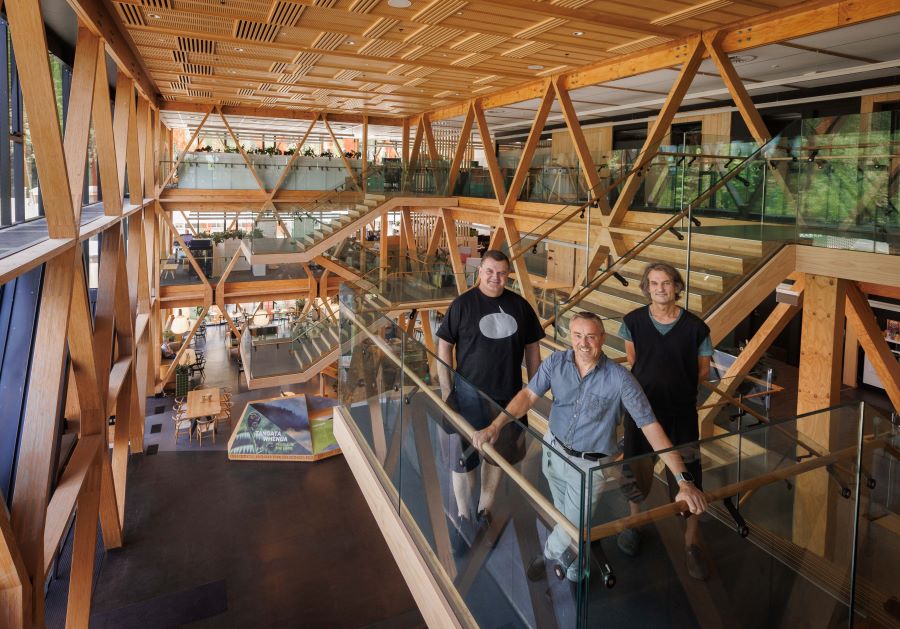Hey Google, name the most beautiful, innovative, iconic building
Scion’s Rotorua HQ has beat out the Silicon Valley campus of tech giant Google.
Scion’s Rotorua headquarters has gone head-to-head with the Silicon Valley campus of top tech company Google — and come out on top.
But there are no hard feelings between the architects behind the two incredible buildings.
The Dubai International Best Practices Award for Sustainable Development was presented on February 13 and Scion’s Innovation hub Te Whare Nui o Tuteata won ‘The Most Beautiful, Innovative and Iconic Building’ award.
Designed by RTA Studios and Irving Smith Architects, it was a finalist alongside Google Bay View in the United States designed by Danish studio Bjarke Ingels Group (BIG) and London-based Heatherwick Studio.
The Dubai award celebrates work that innovates the building industry and Te Whare Nui o Tuteata and Google’s building both achieve that - Kai-Uwe Bergman
Jeremy Smith of Irving Smith gave BIG partner Kai-Uwe Bergmann the grand tour of the Rotorua building while Bergmann was visiting New Zealand for an architecture conference a few days after the awards.
Walking through the doors of Te Whare Nui o Tuteata for the first time, Bergmann says he was struck by the timber building’s warmth.
“Being a finalist in the same category is a great honour. The Dubai award celebrates work that innovates the building industry and Te Whare Nui o Tuteata and Google’s building both achieve that.”
The awards were held for the first time since 2019 in Dubai at the World Governments Summit. The five categories attracted almost 3000 entries worldwide.

The Most Beautiful, Innovative and Iconic Building category recognises iconic, smart, innovative, human-centric sustainable projects that innovatively combine green design and construction practices with modern architectural excellence.
The win adds to the list of more than 20 national and international awards Te Whare Nui o Tuteata has taken home since opening in 2021.
The building’s name, meaning the great house of Tuteata, acknowledges Tuteata who is the ancestor of the three hapū who are the tangata whenua here: Ngāti Hurungaterangi, Ngāti Taeotu and Ngāti Te Kahu. The name was gifted to Scion by those three hapū.
The three-storey 2000m2 building was built using a diagrid timber structure using less material than traditional structures. Scion tested the strength of the diagrid components. The building has also been designed to be carbon-zero.
Google Bay View, which opened in 2022, consists of three buildings totaling 1.1 million sq ft on a 42-acre site in Silicon Valley. The campus aims to operate on 24/7 carbon-free energy by 2030 and renewable energy and solar potential were prioritised.
Globally, the built environment is responsible for about 40% of energy related carbon emissions. Bergmann says architects are increasingly finding new ways to incorporate timber into their multi-storey designs, but more education is needed.
“We look at the operational energy of a building often but more important is the embodied energy, and that’s the building materials that we use. Fortunately, we are at a time when timber is an option,” he says.
“There are structural advancements and pre-engineered wood manufacturing advancements happening alongside changes to building codes. High rises built using timber are getting up to 20 or 30 floors tall around the world.”
This building is achieving exactly what Scion is doing with its research – having an impact on the world stage - Jeremy Smith
Smith says winning the award is fantastic. “It feels amazing to be doing this kind of innovative work and to get noticed internationally. This building is achieving exactly what Scion is doing with its research – having an impact on the world stage.”
Scion’s Forests to Timber Products general manager Henri Baillères says the win solidifies the building as an “international timber architecture icon”.
“It’s an iconic building because there are a lot of elements attached to it. There are the Māori cultural elements, innovative design elements, seismic resistance, elegant design and maximal use of timber.
“It’s a showcase technically and aesthetically of what can be done with timber.”
He says Scion led the sustainable building charge and this had flow-on effects, with the new Fisher and Paykel global headquarters being designed by RTA Studio using similar principles of sustainability and timber technology.
RTA design lead Rich Naish accepted the award in Dubai and says it was a “great honour” to receive recognition on the world stage for innovation developed in New Zealand with partners.
“What I believe has been recognised is a prototype for change to mitigate the effects of climate change in the construction industry, not just applicable to our region but the whole world.”
Go deeper on the building and its awards.
